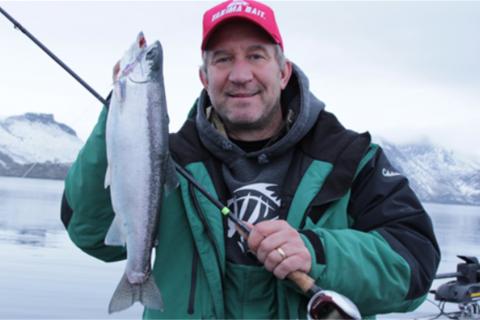
The Simple In-Line Spinner is a Great Lure for Catching Trout
By Scott Haugen, Cabela's Ambassador
When it comes to catching rainbow trout from a river or lake, one of the best approaches is a lure. Fishing lures and spinners work great, year round, but the key is knowing how to fish them.

Copolymer
As for rigging spinners, simply tie them to a 4 or 6 pound mainline; I like P-Line CXX-Xtra Strong line due to the true line diameter, its strength and low visibility. For most lures and some spinners, a small snap swivel will be needed to prevent the line from twisting.
A favorite trout spinning rod of mine is a two-piece, 6-foot, 6-inch G.Loomis GL2 Trout & Panfish Spinning Rod with a 4- to 8-pound-test fishing line rating and handling 1/16- to 5/16-ounce lures. Pair this with a Shimano Symetre reel for ease of casting and reeling.
Be Mobile When Casting Spinners in a Lake or Pond
The last thing you want to do is stay in one place, casting repeatedly to the same spot. Don’t expect fish to find you, rather you go on the search for them. Make each cast land in a different spot, and vary the speed of your retrieve.
 If the amount of bank you can cover on a lake is limited by brush, steep cuts or other obstacles, then work all the water you can with one presentation, then switch to another and cover the same water, again. Vary the color, size and action of the lures and spinners being used. Oftentimes, all it takes to get a finicky trout to bite is giving it a different spinner to look at.
If the amount of bank you can cover on a lake is limited by brush, steep cuts or other obstacles, then work all the water you can with one presentation, then switch to another and cover the same water, again. Vary the color, size and action of the lures and spinners being used. Oftentimes, all it takes to get a finicky trout to bite is giving it a different spinner to look at.
When Fishing Rivers With Spinners
Let the speed of the river current dictate how you fish.
In the upper sections of a riffle, the water is shallow and fast flowing, so work current edges. As you reach the middle of the riffle, the water gets deeper and more riffles and boils are encountered, so you might need to go with a heavier spinner and work every inch of water, including the middle of the river. Keep the rod tip a couple inches above the water so the spinner stays deep, where the fish are.

As you reach the end of the rifle, the water gets deeper and slower moving, and this is where many trout congregate. Work the edges, behind any boulders and along rock ledges. This is a good place to jig spinners and lures, as the falling action will often elicit a strike.
At the very end of the riffle you get to what’s called a tail-out. This is where the water shallows and starts moving faster as it spills into the head of the next riffle. Tail-outs are usually clear, so be careful not to spook trout as you fish.
Using the Best Spinner Bait for Trout
Some of the best all-around trout spinners include a Rooster Tail like Worden's Lures Rooster Tail Trout Pak, the Thomas Buoyant, Mepps Spinner and Dardevle lures. Of course, there are others, and a bit of research into what historically seems to catch trout in the waters you’ll be fishing, can save a lot of time. Get a selection of spinners and lures, including different colors and sizes, and be willing to try them all.
It doesn’t take much gear to be a successful trout angler, and nowhere is this truer than when it comes to fishing spinners.
Pay attention to the water, make each cast count, and you’ll soon be on your way to putting more trout on the dinner table.
- 4633 views

